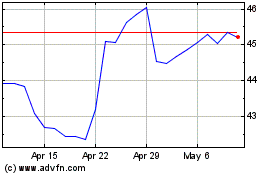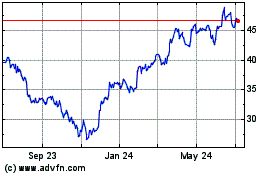What Is Tesla Really Worth?--Heard on the Street
April 16 2017 - 2:26PM
Dow Jones News
By Charley Grant
Tesla Inc. is valued as though it will soon conquer the U.S.
auto market. Now, it has the small task of actually doing so.
Tesla shares have been unstoppable ahead of the Model 3 launch,
having gained 40% this year. The upstart auto maker is more
valuable than Ford and slightly less valuable than General Motors
on a market cap basis. The crux of the excitement is the
all-electric Model 3 sedan that Tesla says will start at $35,000.
Production is scheduled to begin this summer.
Tesla now trades at 271 times projected 2018 adjusted earnings,
according to FactSet. Ford and GM, in contrast, trade at less than
seven and six times the 2018 estimate, respectively. Tesla gets
that valuation because it is expected to upend the auto industry,
while earning big profits that would bring down the multiple.
But to actually earn enough profits to reduce Tesla's multiple
to something in the realm of reasonable would require almost heroic
assumptions. First, the basics: Say Tesla's valuation should be 10
times higher than GM and Ford's, and say Tesla's share price stays
constant at about $300. That means Tesla would need to earn $4.29 a
share in 2018, which equals $700 million in total net income,
assuming the current share count doesn't change.
For perspective, Tesla sold about 76,000 cars in 2016 and lost
$675 million on sales of $7 billion.
Now the assumptions: CEO Elon Musk forecasts Tesla can produce
500,000 cars in 2018, while analysts, a bullish lot, peg the number
of deliveries at 302,000. Let's say the delivery number is 380,000.
Pencil in an average selling price of $50,000 -- Tesla will still
be selling high-priced Model S and Model X vehicles along with the
Model 3. That scenario yields just under $21 billion in automotive
revenue. Add another $2 billion in sales from its residential solar
and energy businesses.
Tesla has never generated a positive operating margin for a full
year, but assume it gets savings on battery costs and realizes
economies of scale. If Tesla gets the same 5.4% operating margin
that GM and Ford averaged last year, it would generate operating
income of $1.1 billion. Subtract $200 million for interest expense
and tax the remainder at 25%: The result is $700 million in net
income, giving Tesla a multiple roughly 10 times bigger than GM and
Ford.
To get there, the company would have to quintuple the number of
cars it sells, earn margins equivalent to those of its highly
efficient competitors and not sell new shares. Tweak any of these
variables -- lower sales, lower margin, lower selling price -- and
Tesla doesn't come close to earning enough to get to 10 times the
multiple of its bigger rivals by the end of 2018.
Valuation has never mattered before for Tesla's investors and it
may not matter at the end of next year. Shareholders may be willing
to wait five years instead of two for Tesla to generate big
profits, or they may continue to figure that valuation doesn't
matter for a game-changer like Tesla.
Tesla's cars have always outshone its financials. That needs to
change soon for its valuation to make sense.
Write to Charley Grant at charles.grant@wsj.com
(END) Dow Jones Newswires
April 16, 2017 14:11 ET (18:11 GMT)
Copyright (c) 2017 Dow Jones & Company, Inc.
General Motors (NYSE:GM)
Historical Stock Chart
From Mar 2024 to Apr 2024

General Motors (NYSE:GM)
Historical Stock Chart
From Apr 2023 to Apr 2024
